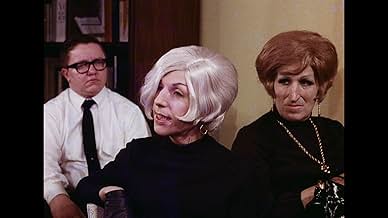Aggiungi una trama nella tua linguaSex hygiene film about transsexuals in the late 60's/early 70's. As with all sex hygiene films it's one part serious documentary and one part sensationalism.Sex hygiene film about transsexuals in the late 60's/early 70's. As with all sex hygiene films it's one part serious documentary and one part sensationalism.Sex hygiene film about transsexuals in the late 60's/early 70's. As with all sex hygiene films it's one part serious documentary and one part sensationalism.
- Regia
- Sceneggiatura
- Star
Harry Reems
- Rhoda's Cab Driver
- (as Tim Long)
Ursula Austin
- Blanche
- (non citato nei titoli originali)
Arlana Blue
- Rhoda
- (non citato nei titoli originali)
Vanessa del Rio
- Sandy
- (non citato nei titoli originali)
Michael Gaunt
- Tom
- (non citato nei titoli originali)
Richard Towers
- John in Park
- (non citato nei titoli originali)
Leo Wollman
- Self - Leo Wollman M.D.
- (non citato nei titoli originali)
Recensione in evidenza
An extension of the Mondo-style documentary, with their "mission" to illustrate, and exploit unknown or forgotten cultural practises and habits, Doris Wishman's (see Review #298: 'Deadly Weapons' (1974)) Let Me Die a Woman follows the work of sex reassignment surgeon Dr Leo Wollman (who also acted as the films adviser), and his work with both post- and pre-op transsexuals. The film has interviews with the aforementioned doctor, along with several transsexuals in various stages of transformation, and also throws in some re-enactments and dramatisations of some of their experiences.
Whilst this is billed under the exploitation banner, and would have been shown in these types of cinema, the film is not overly exploitative, and presents the stories and their participants in quite a sympathetic manner. However, the film does explore, in a very graphically visual manner the operations required to alter the genitalia. Of course with this being made in the 1970's means that the screen is filled with incredibly hairy, militant-looking pubic areas, whilst these men with tits flash their flaccid c***s for the camera. In one scene the doctor probes a post-op vagina with his fingers - a sexual orifice so hideous that I simply had to avert my eyes.
Aside from the Mondo movies (and of course Faces of Death (1978) et al), I am not really aware of any other exploitation film that used this documentary style to expose new, sometimes weird phenomenon - except for Being Different (1981) that focused on exploiting circus sideshow acts, and included a modern day Elephant Man - so I am unqualified to state whether this film is emblematic of it's kind. What does strike me is the fact that this type of documentary was so new, and also that it was marginalised to the exploitation/grindhouse circuits. The subject matter, and the gratuitousness of the film highlights to me how this kind of "exploitation" is in fact now a fundamental part of prime-time television, with shows such as Embarrassing Bodies or any others of the many, many similar formats that infest our screens, in our homes, whilst we f*****g eat our dinner! Given this parallel, and shift in the ways in which the participants are exploited in the modern-day TV show and the cinematic format, the film is pretty naive.
www.the-wrath-of-blog.blogspot.com
Whilst this is billed under the exploitation banner, and would have been shown in these types of cinema, the film is not overly exploitative, and presents the stories and their participants in quite a sympathetic manner. However, the film does explore, in a very graphically visual manner the operations required to alter the genitalia. Of course with this being made in the 1970's means that the screen is filled with incredibly hairy, militant-looking pubic areas, whilst these men with tits flash their flaccid c***s for the camera. In one scene the doctor probes a post-op vagina with his fingers - a sexual orifice so hideous that I simply had to avert my eyes.
Aside from the Mondo movies (and of course Faces of Death (1978) et al), I am not really aware of any other exploitation film that used this documentary style to expose new, sometimes weird phenomenon - except for Being Different (1981) that focused on exploiting circus sideshow acts, and included a modern day Elephant Man - so I am unqualified to state whether this film is emblematic of it's kind. What does strike me is the fact that this type of documentary was so new, and also that it was marginalised to the exploitation/grindhouse circuits. The subject matter, and the gratuitousness of the film highlights to me how this kind of "exploitation" is in fact now a fundamental part of prime-time television, with shows such as Embarrassing Bodies or any others of the many, many similar formats that infest our screens, in our homes, whilst we f*****g eat our dinner! Given this parallel, and shift in the ways in which the participants are exploited in the modern-day TV show and the cinematic format, the film is pretty naive.
www.the-wrath-of-blog.blogspot.com
- tomgillespie2002
- 4 mag 2012
- Permalink
Trama
Lo sapevi?
- QuizFilm was originally released in 1972 in a significantly different form under the title Strange/Her.
- BlooperThere is reason to believe the cause of the transsexual phenomenon is a genetic defect, not a psychological condition per se as is suggested in the film.
- Versioni alternativeA "screwdriver castration" sequence was deleted from the film and thought to be lost, but was in fact recovered from the original camera negatives.
- ConnessioniFeatured in American Grindhouse (2010)
I più visti
Accedi per valutare e creare un elenco di titoli salvati per ottenere consigli personalizzati
- How long is Let Me Die a Woman?Powered by Alexa
Dettagli
Contribuisci a questa pagina
Suggerisci una modifica o aggiungi i contenuti mancanti

Divario superiore
By what name was Let Me Die a Woman (1977) officially released in India in English?
Rispondi



















